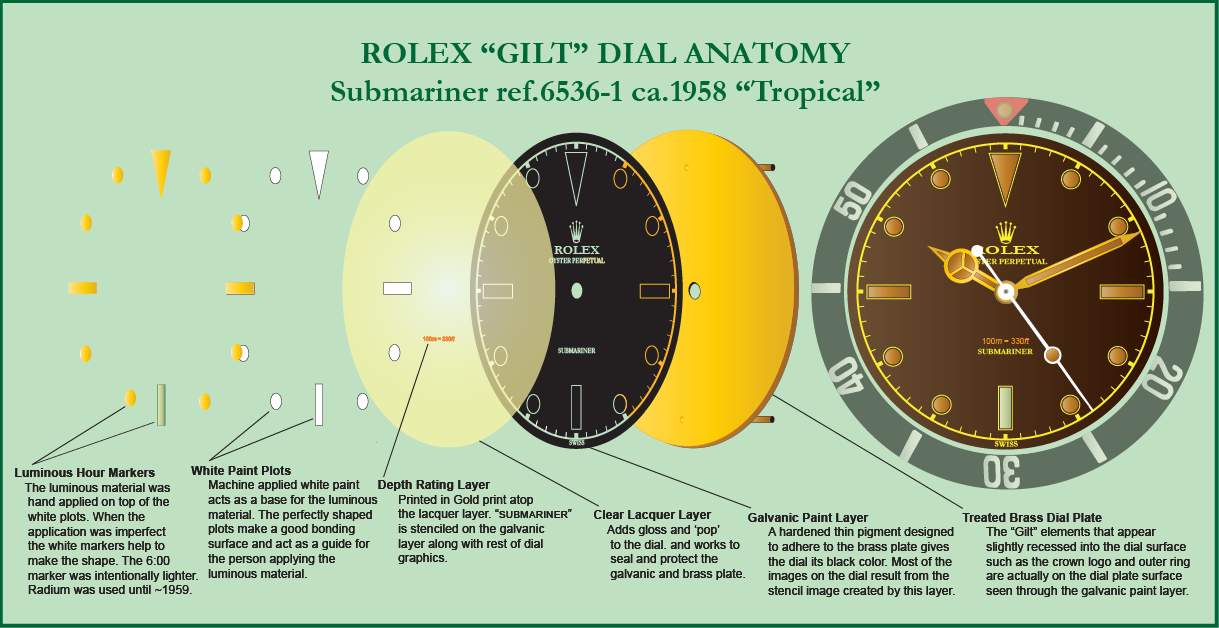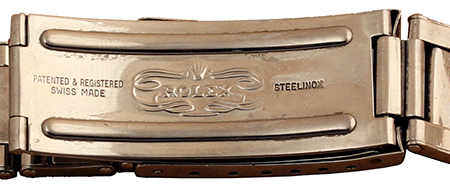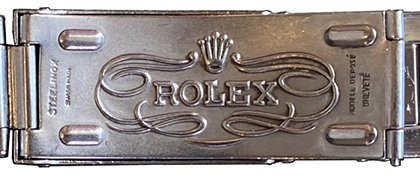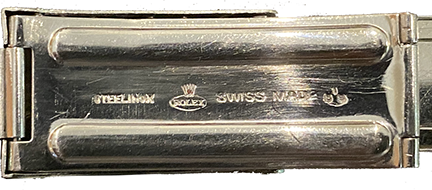The most interesting feature on this Submariner 6536-1 is the "Tropical" or "Color Change" dial. Although the materials and manufacturing process were the same for normal black dials, in this rare instance, the black galvanic layer has lost some of its pigment. The loss of opacity allows the underlying brass plate to show through, causing the dial to turn a brown color. This phenomena is uncommon and unique in each instance, and therefore no two Tropical dials are exactly the same. The clear lacquer layer yellows with age which gives the lettering and graphics a gold-copper tone.
Although theories abound, the cause and length of time it takes for a Tropical dial to develop are still largely a mystery.
Case No. 398,639
It is strongly suspected that humidity contributes to the effect because a significant number of watches with Color Change dials have originated from tropical parts of the world. The intensity of the color change can range a wide gamut. Some dials have a slight color change and need to be in direct sunlight for the effect to be noticeable, while others, with more profound color shifts, have a visible brown tone even without direct light. The condition of Tropical dials also varies greatly. Some are perfectly preserved with full gloss and no deterioration of the luminous material, while others have changed color from water damage. Only a precious few of these dials survive because they were all considered defective and routinely replaced by Rolex and watchmakers during service. As a result, well preserved specimens are extremely rare and valuable.

The luminous material on the dial and hands was manually applied Radium like most Small Crowns from the 1950s. Although it no longer glows in the dark, the Radium still has a distinct "speckled" glow when exposed to UV Light and has a relatively high Geiger reading as well. Please see the "Luminous" section for further information about characteristics of glow-in-the-dark materials used by Rolex.
The hands are made from a metal alloy that was gold-plated. They are also flat on top, a design that came to be known by collectors as "Gilt Hands." When the hands move about the face of the dial, the sweep-seconds hand appears to lightly graze the "Chapter" ring of the minute track. When it briefly glides over the minute hand, they are perfectly aligned.
The outer case back is flat and the reference number 6536/1 is stamped inside the case back with a date code. The Submariner 6536-1 is powered by the Rolex 1030 Automatic movement. The Submariner 6536-1 and Submariner 5508 were made concurrently.



A newer variety of bracelet clasp designs were introduced by Rolex bracelet maker Gay Frères in 1958. Although the rivet and end links remained unchanged, two new clasp designs were introduced and the earlier Tiny Logo clasp was phased out. Additional details about end links and bracelets can be found here.
Small Logo clasp introduced in 1958
Rolex also contracted with C&I to make bracelets in the United States. The import duties on Swiss made bracelets was becoming cost prohibitive and it made more economic sense to have a US based manufacturer. C&I produced Hollow Rivet bracelets with unmarked end links that have a markedly lighter gauge than Swiss made bracelets.

Big Logo clasp introduced in 1958

Tiny Logo clasp phased out in 1958
US Made C&I Rivet Bracelet 1958
RolexHaven.com is intended for informational purposes only and is in no way sponsored, endorsed,
or affiliated with Rolex U.S.A., Rolex S.A. or any other Rolex worldwide subsidiary. © All Rights Reserved 2020